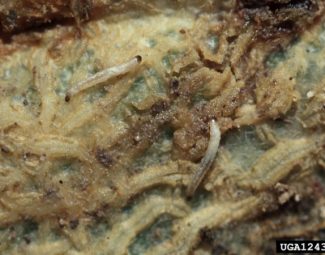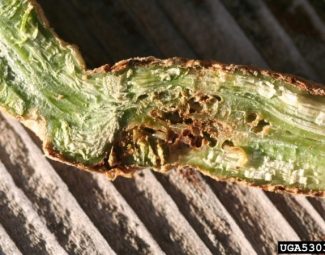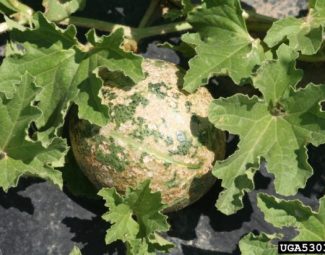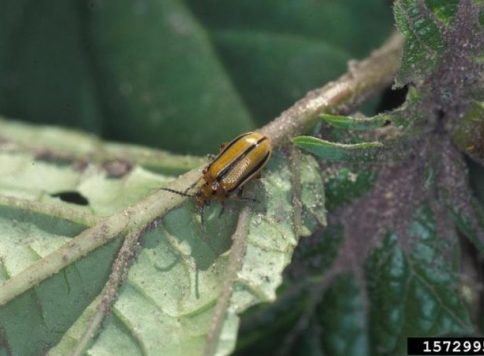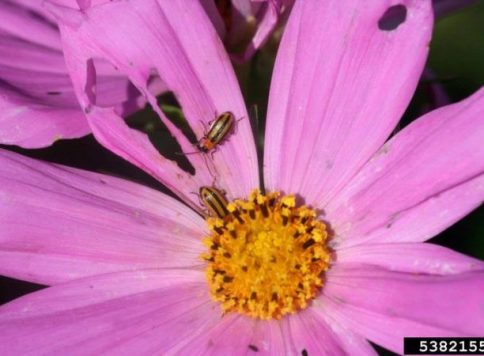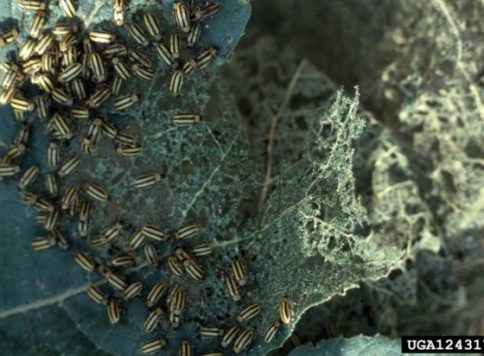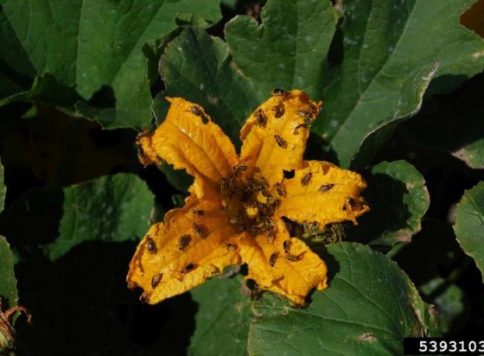Striped Cucumber Beetle
Insect Summary Report
Acalymma vittatum
General Information
- Striped Cucumber beetle is a vector for bacterial wilt disease (Erwinia tracheiphila) in most cucurbits along with squash and cucumber mosaic virus (and others). Root feeding increases vulnerability to Fusarium.
- Adults will eat holes in leaves and pods of host plants. Larva will feed on roots and tunnel through stems.
- Prefer cucurbit species to other crops. Turk’s Turbin and Blue Hubbard squash varieties are especially preferred hosts. Other preferred crops include zucchini, cucumbers, yellow summer squash and acorn squash. Slightly less preferred are pumpkins, muskmelons, butternut squash, and watermelon.
- Adults use aggregation pheromone to attract other adults when suitable host plants are found.
Life Cycle (40-60 Days)
- Eggs… (5-8 Days) Light yellow or orange in color and round to oval shaped. Can be found singly or in clusters in soil around the base of host plants.
- Larva… (2-4 Weeks) 3/8 in. long. White with a dark head.
- Pupa… White or yellow. About ¼ in. long. Develop in soil.
- Adult… About ¼ in. long. Yellow-green with 3 black stripes that start at the base of the head and extend to the back tip of the abdomen. Prefer to lay eggs in moist soils which improves fecundancy. Can lay up to 1000 eggs or more over a 6-week period.
Over-wintering Strategy
- Unmated adults over-winter under the protection of insulating material such as leaf, brush, and trash piles.
- Will emerge in late March or early April in temperatures 65 degrees or higher.
Organic Control
- General Info
- Natural enemies include soldier beetles, tachinid flies, braconid wasps and certain nematodes (Steinernema riobravis).
- Protective screens.
- Trap Crop Early planted trap crop of a preferred host such as squash that can serve as trap crop. Trap crop should be monitored and appropriate control measures should be implemented to prevent trap crop from becoming source of infestation.
- Commonly Used Products
- Ferti-Neem Oil
- Ferti-Organics Karanja Oil
- Biorepel (Garlic Oil)
- Neemix 4.5 (Botanical)
- Pyganic 1.4 (Botanical)
- Pyganic 5.0 (Botanical)
- Various Oils: Trilogy, Tritek, Ecotrol Plus, Cedar
- Soaps: Des-X
- Mycotrol ESO (Biological)
- BoteGHA ES (Biological)
Cultural Control
- Cultivate soil thoroughly to disturb any over-wintering adults in soil.
- Plant preferred host market crops as late as possible in the spring to force adults to alternate food sources.
- Use of aluminum coated plastic row covers to protect plants, especially during early plant development when seedlings are especially vulnerable. Must be removed prior to bloom.
- Heavy mulching.
- Crop rotation.
- Limit or eliminate likely over-wintering sites such as trash and brush piles.
- Eliminate weeds that serve as alternate hosts.
- Remove entire plants that show evidence of bacterial wilt disease.
More Images of the Striped Cucumber Beetle
Bibliography
- Images by Gerald Holmes, California Polytechnic State University at San Luis Obispo, Bugwood.org (eggs and adults on plants)
- Images by Whitney Cranshaw, Colorado State University, Bugwood.org (adults feeding on pumpkin, vine, tunneling at plant base, larvae in cantaloupe rinds, chewing injury to flower, fruit skin scarring, and adults mass on squash leaf)
- Image by David Cappaert, Bugwood.org (adult close up)
- Image by Howard F. Schwartz, Colorado State University, Bugwood.org (infestation on pumpkin plant)
- http://ohioline.osu.edu/hyg-fact/2000/2139.html (life cycle, over-wintering emergence, natural enemies, disease vector).
- http://www.vegedge.umn.edu/vegpest/CUCS/scb.htm (life cycle)
- http://www.hort.uconn.edu/Ipm/veg/htms/cukbtltcrop.htm (preferred hosts, aggregation pheromone, natural enemies, black plastic mulch, Fusarium)
- Caldwell, John S. and Paul Clarke. 1998. Aluminum-coated plastic for repulsion of cucumber beetles. Commercial Horticulture Newsletter, January-February 1998. Virginia Cooperative Extension. Virginia Tech.


